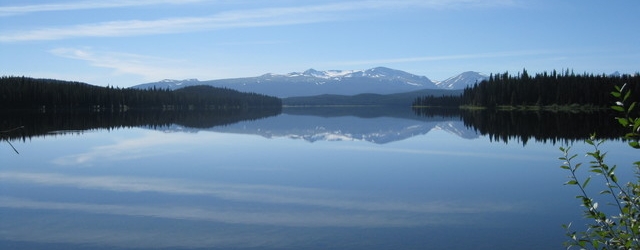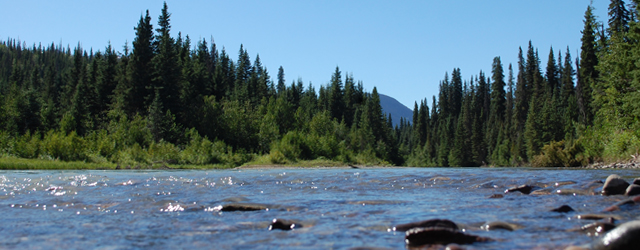Wet’suwet’en Nation
The territories of the Wet’suwet’en Nation span more than 40,000 square kilometers in central British Columbia, and include some of the region’s greatest river salmon fisheries including those of the Skeena, Babine, Bulkley, and Morice Rivers.
Twelve House Chiefs take care of the fishing sites at the summer villages and distinct tracts of the territory for their clan members.
Location & Significant Feature
The Office of the Wet’suwet’en was created as a central office for the Wet’suwet’en Nation. The Office offers many services throughout the traditional territories focusing on the main areas of Lands and Resources, Fisheries & Wildlife, Human and Social Services and Governance.
Our office is governed by the Wet’suwet’en Hereditary Chiefs residing throughout the traditional territories. The Chiefs meet at least monthly and often weekly to address specific issues that management needs direction for. Meetings are held throughout the territories in various locations.
Communities
- Hagwilget
- Witset
- Browman Lake
- Skin Tyee
- Nee Tahi Buhn

Wet’suwet’en Social Structure
House Members
Matrilineage (following the mother’s side of the family), clearly places every Wet’suwet’en person within a house and clan. As a member of this group the actions of each individual affect the house to which they belong.
Sub Chiefs
Second highest titles are those of thirteen sub chiefs who have important responsibilities for the administration of discreet parts of their house’s territory. These Subs Chiefs also assist in the decision making processes used to govern the welfare of the House Members.
House Chiefs
The highest Hereditary titles in the Wet’suwet’en Nation are the twelve House Chiefs. These Chiefs take care of the fishing sites at the summer villages and distinct tracts of the territory for their clan members.
Clans
A clan is a group of people belonging to a particular Tribe or House to identify families and territories. There are five Wet’suwet’en clans:
- Gilseyhu (Big Frog)
- Laksilya (Small Frog)
- Gitdumden (Wolf/Bear)
- Laksamshu (Fireweed)
- Tsaya (Beaver clan)
In the feast hall they operate as four Clans with Laksamshu and Tsayu clans working together.

Mission
The Wet’suwet’en Fisheries team is dedicated to the stewardship and sustainable management of the fisheries resources within the Wet’suwet’en territory.
Strategic Goals
- Manage salmon stocks so that conservations needs for Chinook, Coho, pink, sockeye and steelhead are met,
- To ensure the stocks are sufficient to meet food and cultural needs
- To gain economic benefits from stocks that can support a commercial fishery.
Objectives
Carry out activities that enable management of the stocks: Gather data that enables us to make responsible decisions regarding fish management for salmon (Chinook, Coho, pink, sockeye and steelhead), as well as other species such as trout, char and lamprey eels.
Identify stocks within each species by collecting DNA from species.
Develop population estimates by carrying out a mark and recapture project
Determine run timing of each species and stock through various fisheries
Determine Wet’suwet’en food fishery impacts on fish stocks by gathering accurate catch data in Morristown Canyon
Determine impact of other user groups’ impact on fish stocks by obtaining catch data from other groups including:
- Commercial fisheries
- Recreational fisheries
- Other First Nation food fisheries
Estimate spawning escapement through:
-
- Stream walks
- Over-flights of spawning areas
Develop harvest plans prioritized by:
- Conservation needs
- Food, cultural and ceremonial needs
- Commercial sales
- Sports fisheries
Obtain Wet’suwet’en support regarding fisheries plans, including:
- Morristown Canyon Committee
- Office of the Wet’suwet’en
- Communities through meetings
- Publish reports through meetings,, reports, newsletters and media
Enforce regulations for First Nation food and commercial fisheries to:
- Protect weak stocks
- Prevent overfishing of all stocks by preventing illegal commercial fisheries
- Address community concerns regarding health and safety issues within Moricetown Canyon
- Enforce ESSR fisheries to ensure DFO’s sales conditions are followed
Protect fish habitat by:
- Identifying spawning and rearing areas in conjunction with the Natural Resource Departments mapping system.
- Reviewing land use referrals for impact on fish habitat
- Conducting stream walks to monitor fish habitat
- Gather water quality data in the upper Morice watershed
Make sure fisheries resources are allocated fairly and equitably among the Wet’suwet’en communities, especially:
- Food fish
- Employment
Participate in processes that may impact fish stocks:
- Treaty negotiations
- Skeena Fisheries Technical Committee, an organization with representatives from FN organizations in the Skeena watershed, whose purpose is to address issues that may affect all FN in the watershed.
- First Nations Fisheries Council, a Province wide organization for aboriginal fisheries
Develop allegiances that enhance our goals and objectives
- Skeenawild Conservation Trust
- Moore Foundation
- Coastal commercial fishermen
- Lake Babine FN and Gitxsan Watershed Authority

Modern Fishery
The Office of the Wet’suwet’en employs 3 full time fisheries staff and 20 seasonal staff dedicated to managing the diversity of salmon stocks and habitats that span the territory. Chiefs control the fisheries that prioritize the Food, Social and Ceremonial needs of the clans. These fisheries employ traps, spears and dipnets, using gill nets and beach seines where fish are concentrated.
Where available surpluses have been identified modern commercial fishing may include the use of gill nets and beach seines, while dip nets are still the preferred harvest method.
bï lhok ulggit in the Wet’suwet’en landuage means “fishing spear”.





